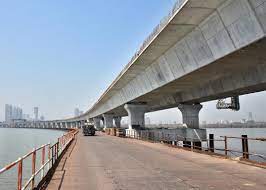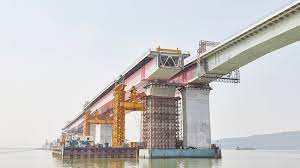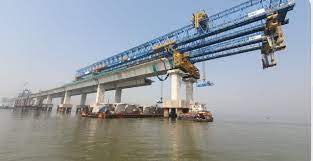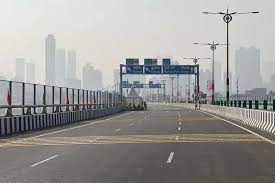Prime Minister Narendra Modi recently inaugurated the Mumbai Trans Harbour Link (MTHL) on January 12, marking a historic milestone in India’s infrastructure development. It is also known as Atal Setu, honouring the late former Prime Minister Atal Bihari Vajpayee. The 21.8-kilometre-long bridge between Sewri in Mumbai and Nhava Sheva area in Raigad district will bring down the journey from the current two hours to around 15-20 minutes. It provides direct connectivity to the Nhava seaport, the Mumbai – Pune Expressway and the Mumbai – Goa Highway. With 16.5km over water, it is the longest sea bridge in India and the 12th longest in the world.
MTHL – How it Began?
The MTHL was first proposed in 1963. It was then called the Uran Bridge, but it never really went through at that point. The first real attempt at the bridge was made in 2006 when IL&FS submitted a proposal to make the bridge in a Build Own Operate Transfer (BOOT) model. However, this was also sidelined. Finally, in 2017, the Maharashtra Govt decided that MTHL would be built by MMRDA via EPC (Engineering – Procurement – Construction) model with official development loan assistance from JICA (Japan International Cooperation Agency). The construction started in 24 April 2018 and is now operational.

Engineering, construction details, implementation and packages
Financed by the Japan International Cooperation Agency (JICA), the MTHL Bridge is a 22-km-long six-lane marine road bridge implemented by the Mumbai Metropolitan Region Development Authority (MMRDA).The total cost of MTHL is 17,843 crores.
Engineering and Construction In-Charge
- Engineering Design by: AECOM, PADECO, Dar Al-Handasah, T. Y. Lin International
- Constructed by: Larsen and Toubro, IHI Corporation, Daewoo E&C, Tata Projects Limited, EFKON, Strabag
This ambitious project was built in four packages;
Package 1 – Bridge spanning across Thane Creek and Sewri Interchange – 10.38km
Package 2 – Bridge portion across Thane Creek and the Shivaji Nagar interchange – 7.8km
Package 3 – Viaducts and interchanges that connect MTHL with State Highways 52 and 54 and National Highway 4B at Chirle – 6.3km
Package 4 – Intelligent Transport Systems (includes Toll and Transport Management System) and equipment installation for the project.
Width and capacity of the bridge
- The bridge comes with an impressive width of 27 metres (89 ft), providing ample space for vehicular movement.
- The bridge is designed to accommodate up to 70,000 vehicles per day, catering to the transportation needs of commuters traveling between Mumbai and Navi Mumbai.
- The bridge accommodates six lanes of traffic, ensuring efficient flow in both directions.
- The bridge also incorporates two emergency exit lanes, enhancing safety measures for commuters.
Key Features of Mumbai Trans Harbour Link Design:


- Earthquake Resistance: The bridge is equipped with 254 seismic isolation bearings, which provide a cushion between the bridge deck and its supporting piers. This innovative feature allows the deck to move independently during earthquakes, absorbing the shock waves and safeguarding the structure from potential damage. Additionally, the use of ductile concrete piers, designed to bend without breaking, further enhances the bridge’s resilience to seismic activities.
- High-Performance Concrete: The concrete blend used in the construction is engineered to resist the corrosive effects of seawater and the extreme weather conditions of Mumbai. Its specialized formulation minimizes heat generation, reducing the risk of cracks and ensuring the longevity of the bridge.
- Precast Segments: The bridge’s deck is composed of precast concrete segments that are manufactured off-site and then assembled with precision on-site. This method not only speeds up the construction process but also maintains high-quality standards and minimizes environmental disruption.
- Caisson Foundations: Essential for stability in the marine environment, caisson foundations provide a robust and watertight base for the sea bridge. These structures are crucial for maintaining the integrity of the bridge amidst the challenging conditions of the sea.
- Underwater Construction: The construction of the bridge’s pylons and foundations involved complex underwater operations, necessitating the use of skilled divers and sophisticated equipment like remotely operated vehicles (ROVs).
Use of Orthotropic steel bridge decks for the project
The OSD is a steel deck superstructure that has lesser self-weight than concrete or composite. However, it will carry the vehicular load more efficiently and improve the load-carrying capacity of the bridge as compared to the concrete superstructure for a similar span.
Learn more- what-are-orthotropic-steel-bridge-deck
Orthotropic steel bridge decks design and manufacturing
MTHL bridge consists of 70 orthotropic decks weighing 84,000 tons These decks represent a revolutionary approach to bridge construction, as they enable longer spans without relying on traditional girders. Manufacturing these orthotropic decks required meticulous consideration of materials. High-strength steel, chosen for its durability and load-bearing capabilities, forms the backbone of these decks. The steel components were sourced from technologically advanced countries such as Japan, known for their precision engineering. The selection of materials reflects a commitment to using the best available resources to ensure the longevity and resilience of the bridge.


These decks, an important component of the bridge’s superstructure, are engineered to offer exceptional strength and durability. The unique feature of orthotropic decks is their ability to distribute loads efficiently, allowing for extended spans and reducing the need for additional supporting structures. The use of these decks not only enhances the structural integrity of the MTHL but also sets a precedent for future bridge construction projects in India.
Prefabrication and Transport of Orthotropic Steel Bridge Decks
The efficiency-driven approach of the MTHL project is exemplified by the emphasis on prefabrication, where only about 3% of the bridge structure was constructed on-site. The majority of components, including the crucial steel decks, were prefabricated in countries known for their advanced engineering capabilities – Japan, Myanmar, Taiwan, and Vietnam. These prefabricated components were then meticulously transported to Karanja Port in Uran for the final assembly phase. This strategy not only accelerated the construction process but also showcased a remarkable global collaboration, as components from diverse locations seamlessly came together to form an integral part of this engineering marvel. The precision and coordination required for this prefabrication approach demonstrate a forward-thinking mindset in large-scale infrastructure development.
*Approximately 120,000 tonnes of structural steel have been utilized, surpassing the quantities used in iconic structures like the Howrah Bridge, Statue of Unity, and the Eiffel Tower.
Innovative Construction Techniques- Reverse Circulation Drilling and Automated Girder Launching System
The MTHL construction required innovative techniques to overcome unique challenges. One standout methodology was the introduction of the Reverse Circulation Drilling (RCD) technique, a pioneering move in Indian construction .
Reverse Circulation Drilling (RCD) is a drilling technique characterised by the opposite flow of drilling fluid compared to traditional methods. In RCD, drilling fluid is pumped down through the drill string, exits the drill bit through nozzles, and carries cuttings back up to the surface. This method enhances cuttings recovery efficiency, allows for faster drilling rates, and is often considered environmentally friendly as it reduces the discharge of drilling fluid. In the case of the Mumbai Trans Harbour Link (MTHL) construction, RCD was introduced for the first time in India to minimise disturbance to migratory birds near the construction site, showcasing its adaptability to specific environmental considerations.

Additionally, the use of automated girder launching systems for laying the bridge’s foundation marked a departure from conventional methods. This forward-thinking approach not only improved efficiency but also highlighted a commitment to incorporating state-of-the-art construction methodologies. The integration of these advanced techniques underscores the project’s dedication to pushing the boundaries of traditional construction practices and embracing cutting-edge solutions to ensure the success of the MTHL.


Workforce and Expertise:
The scale of the MTHL project is evident in its ability to generate 115,419 man-months of employment, involving over 14,000 workers operating round-the-clock in three shifts. The expertise drawn from consultants in 10 different countries, including Brazil, Denmark, Japan, South Korea, Switzerland, the United Kingdom, the United States, and some Middle Eastern countries, further enriched the project with a diverse range of perspectives and insights.
Important features of the bridge
Noise and Vision Barriers:
The MMRDA has implemented noise and vision barriers along a 6 km stretch of the Mumbai Trans Harbour Link (MTHL). These barriers serve a dual purpose – the vision barriers aim to obstruct the view of the Bhabha Atomic Research Centre (BARC) from the MTHL, while the noise barriers work to safeguard the movement of flamingos and migratory birds at the Sewri mudflats. Additionally, the MMRDA has declared nearly 2 km of the MTHL on the Sewri side as a “silent zone,” extending the silent zone designation to areas near schools and other sensitive locations on the Navi Mumbai side. Construction equipment used during the project has been fitted with silencers to mitigate potential noise impact on migratory birds, especially flamingos.
Bird Watching Platform:
During the construction of the MTHL, a temporary 5.6 km long access bridge was erected for the transportation of equipment and workers. In a commendable move towards conservation, the MMRDA has decided against demolishing this bridge. Instead, it will be repurposed into a bird-watching platform, allowing enthusiasts to observe flamingos and other birds. This decision not only contributes to environmental sustainability but also saves the costs associated with demolition.
Traffic Management and Safety Measures:
The MTHL incorporates advanced traffic management and safety measures. As an access-controlled road, it boasts the Advanced Traffic Management System (ATMS), a centralized system enabling real-time monitoring and management of traffic, incidents, and emergency responses. The Intelligent Transportation Management System (ITMS) works seamlessly with the ATMS, earning the MTHL international recognition for its sophisticated traffic management capabilities.
To enhance safety, the MTHL strictly prohibits the entry of two-wheelers, three-wheelers, animal-drawn carriages, slow-moving vehicles, and bicycles. The Mumbai Police have imposed a speed limit of 100 km/h to prevent fatalities, and stopping on the bridge is allowed only in emergencies or under law enforcement guidance.



Security Technology Adaptation:
The MTHL incorporates cutting-edge features, including a Comprehensive Surveillance System (CSS), Speed Violation Detection System (SVDS), Video Incident Detection System (VIDS), Emergency Calling Boxes (ECBs), and Variable Message Display (VMD) systems. These technologies collectively contribute to enhanced safety, communication, and incident management.
Stone matrix asphalt (SMA) for Sustainability:
The environmental safety and sustainability measures adopted by the MTHL are comprehensive. Stone matrix asphalt (SMA) has been used to pave both sides of the bridge, offering high resistance to temperature variations, better adhesion between stone aggregate and bitumen, reduced traffic noise, high skid resistance, and improved road surface marking visibility. The SMA pavements are not only durable but also 100% recyclable, aligning with the project’s commitment to environmental preservation.

Eco-Friendly Lighting Design:
To address concerns about the potential disturbance of marine life by the bridge’s lighting, engineers have strategically installed 1,212 special light poles. These poles illuminate only the carriageways, minimizing luminous spill onto the sea and positively affecting marine life. These eco-friendly lighting measures have played a role in the MTHL and the MMRDA receiving a sustainability certificate from the Bombay Natural History Society (BNHS). The integration of these features underscores the project’s commitment to balancing infrastructure development with environmental conservation and commuter safety.
Importance of MTHL for Mumbai & Navi Mumbai and Connecting Areas
The Mumbai Trans Harbour Link (MTHL) stands as a critical infrastructure marvel, playing a pivotal role in transforming connectivity between Mumbai, Navi Mumbai, and beyond, notably Goa. As the longest sea bridge in India, the MTHL not only addresses the immediate transportation needs of these bustling urban centers but also serves as a gateway to enhanced economic activities and tourism in the region. By seamlessly linking Mumbai and Navi Mumbai, the bridge significantly reduces travel time and congestion, fostering efficient daily commutes and bolstering economic interactions. Furthermore, the MTHL serves as a vital part in the broader regional connectivity, enhancing accessibility to destinations like Goa and creating new avenues for trade, tourism, and cultural exchange.
Conclusion
The Mumbai Trans Harbour Link stands as a monumental stride towards enhancing the city’s connectivity and fostering economic growth. Through meticulous planning and execution, the project promises to alleviate traffic congestion, reduce commute times, and spur development in the surrounding regions. This transformative bridge not only meets immediate transportation needs but also serves as a catalyst for economic growth and regional connectivity, setting a new standard for urban development in the country.
Image references- ndtv.com, english.jagran.com, theprint.com, deccanherald.com, indiatoday.in, newsband.in, timesofindia.com, marathon.in, bridgeweb.com, financialexpress.com



